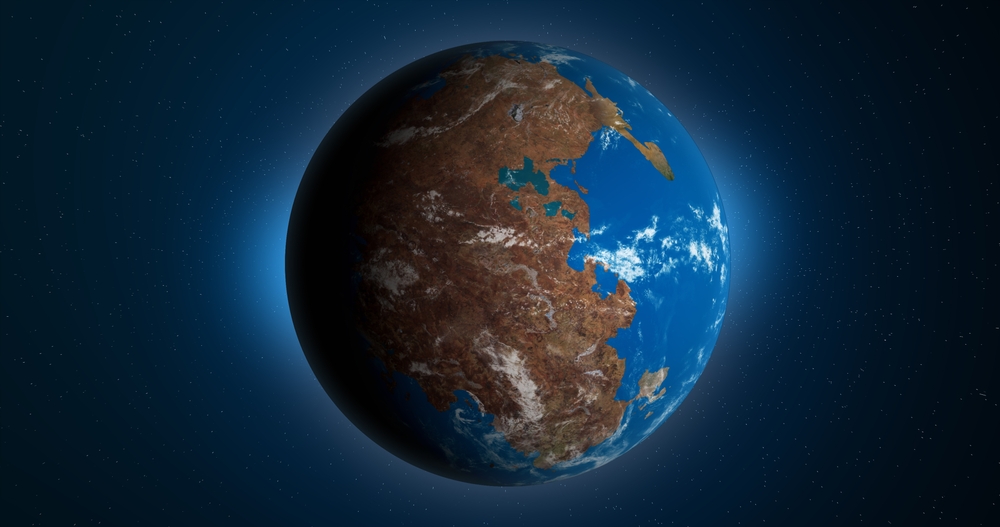From the First Sign of Life to the Dinosaur’s Extinction: How Do We Measure Time on Earth? [Thoughts After Dark]
Share:
Welcome to Thomas Insights — every day, we publish the latest news and analysis to keep our readers up to date on what’s happening in industry. Sign up here to get the day’s top stories delivered straight to your inbox.

Imagine this: the Earth’s surface is so hot that rocks melt into magma, and it’s repeatedly pelted with asteroids and comets. Scientists say our planet’s first 700 million years looked a lot like this during the Hadean Eon.
The Earth’s 4.5 billion-year history is broken into geological phases of time that typically span millions of years, known as the “geological time scale.” This time scale helps us track things like the beginning of life on Earth, when multicellular life was formed, and when dinosaurs became extinct. While these types of events make up an eon, eons are divided into eras, eras into periods, and periods into epochs.
When defining an epoch, researchers must create a record of geological changes that have happened globally, such as ice ages. Recently, scientists uncovered sediment at the bottom of a lake in Ontario, Canada, that signifies a potential shift to a new epoch that, for the first time, was brought on by humans and not a natural phenomenon. The researchers call it the Anthropocene Epoch, a geological phase first proposed in 2000.
But do planetary changes caused by humans deserve their own epoch?
The Geological Time Scale
When we measure time in our own lives, such as getting ready for work, it may be measured in minutes or hours. Geologists use a similar strategy to better define the history of Earth — breaking geological time into larger (eon) and smaller (epoch) chunks to better track and talk about major events. The four parts of the time scale are:
- Eons: Several hundred million years to two billion years
- Eras (eons are subdivided into eras): Hundreds of millions of years
- Periods (eras are subdivided into periods): Tens of millions of years
- Epochs (periods are subdivided into epochs): Hundreds of thousands of years to tens of millions of years
The 4 Eons
Eons are the longest divisions of Earth’s past, separating the last 4.5 billion years of Earth’s history into four sections.
1. Hadean Eon
The Hadean is an informal division of geological time spanning between 4.5 billion and 4 billion years ago. It’s characterized by Earth’s core formation and is often associated with volcanism and asteroid impacts.
Before its orbital path was clean, the Earth was perpetually pelted with rocks flying through space. The impact transmitted a large amount of kinetic energy to the new planet, which was transformed into thermal energy — making the planet piping lava hot. Gravitational compression, radioactive decay, and asteroid impacts also contributed to making the newly formed planet hot. Much of this heat still exists inside the planet today.
The Earth’s crust, mantle, and core were formed by exploding stars, with different elements mixing together to create parts of the young planet. Over tens of millions of years, the differentiation of elements occurred, creating the three layers of the Earth that exist today.
2. Archean Eon
The second of Earth’s eons, beginning between 3.8 billion and 2.5 billion years ago, is defined by ocean formation and the first signs of life.
Archean is named after the Greek word for “beginning,” as this eon represents the beginning of a robust rock record. During the beginning of this eon, the frequency of meteorite impacts slowed, clouds formed, and the Earth’s crust cooled enough to harden into a molten globe.
The Earth was mostly a “water world” during this time, but it began to become a life-supporting, hostable planet. While there was continental crust, much of it was deep under the ocean. The earliest signs of known life, primarily represented by stromatolites or shallow-water microbial mats, remained single-celled organisms for much of this eon.
3. Proterozoic Eon
The third eon, taking place between 2.5 billion and 542 million years ago, was the Proterozoic, and many of the most exciting events in Earth’s history occurred in this eon. It’s not only the longest geological eon, but it also saw the evolution of multicellular life.
During this eon, modern plate tectonics became active, and the cores of the seven continents we know today moved over wide areas of the globe. During this time, continental rifting occurred, and North America almost rifted through its own midsection. The rocks formed during this time — more than one billion years ago — can still be seen around Lake Superior.
The Proterozoic Eon also expanded the amount of oxygen on Earth — noted by the increase of red color in sedimentary rocks — which led to life-forms adapting to using oxygen and creating complex multicellular life.
Near the end of the eon, ice sheets began growing toward the equator, and a thin layer of snow and ice potentially engulfed the whole planet. This triggered ice ages.
The Proterozoic is divided into three eras:
- Paleoproterozoic, taking place 2.5 billion to 1.6 billion years ago, is the longest Proterozoic Era and is represented by continents first stabilizing.
- Mesoproterozoic, taking place 1.6 billion to 1 billion years ago, is marked by the further development of continental plates and tectonics and the evolution of sexual reproduction.
- Neoproterozoic, taking place 1 billion to 542 million years ago, produced most of Earth’s continental crust and is a time of transition between a microbial world and the rise of complex life ahead of the Phanerozoic Eon.
4. Phanerozoic Eon
We’re currently in the Phanerozoic Eon, which began around 542 million years ago and is the eon of visible life. While there is proof that life originated during the Archean Eon, it wasn’t until the Phanerozoic that a rapid expansion and evolution of life-forms occurred.
The Phanerozoic is divided into three eras largely based on the assembling of life-forms.
The 3 Proterozoic Eras
1. Paleozoic Era
Taking place 541 million to 252 million years ago and meaning “ancient life,” Paleozoic is the longest Phanerozoic Era and is marked by the appearance of fish, amphibians, and reptiles.
2. Mesozoic Era
Taking place 252 million to 66 million years ago and known as the age of reptiles, Mesozoic saw the beginning of Pangaea separating into the modern-day continents. During this time, dinosaurs and pterosaurs ruled the land.
3. Cenozoic Era
Taking place 66 million years ago to the present and meaning “recent life,” Cenozoic represents what plants and animals most look like on Earth today. The Cenozoic is often referred to as the age of mammals and is said to have begun when a meteorite crashed into Earth and killed off the dinosaurs.
While we’re currently in the Cenozoic Era, this is broken into several epochs.
Why Break Eras into Epochs?
When I organize a to-do list, I often start with a larger goal and break it into smaller segments to make it more manageable. That’s essentially what an epoch is to an era — it defines important shifts in history that don’t warrant an entire era or eon.
We have the most detailed knowledge of the Cenozoic Era — as we’re still living in it — and it’s the only period of time epochs are defined. Within the era are seven epochs in which natural phenomena have occurred.
For example, the oldest epoch, the Paleocene, occurred around 66 million to 55 million years ago. One of the most interesting features of this epoch is the absence of dinosaurs and other reptiles. However, during this epoch, there was rapid evolution of mammals like opossums and other marsupials, primates, and marine life.
According to the International Union of Geological Sciences (IUGS), the world is officially in the Holocene Epoch, which is classified by a few key features:
- The extinction of certain animals leads to people turning to agriculture for sustenance,
- the evolution of humans leads to the domestication of animals,
- and the innovation of agriculture leads to a rising human population.
However, many geologists and environmentalists across the globe argue that we should classify our current epoch as Anthropocene and that the Holocene label is “outdated.” Scientific experts believe that the Anthropocene, meaning “new human era,” is a reminder that “humans have changed the Earth system significantly enough to produce distinctive stratigraphic signals that should be recognized.”
Are We Entering the Anthropocene Epoch?
First proposed in 2000, the Anthropocene Epoch reflects how human activity has altered the Earth. It’s specifically defined as a single species (humans) controlling the entire planet, using up its resources, and affecting its climate.
The Anthropocene Working Group (AWG), comprised of 35 geologists, has been working for nearly 15 years to make Anthropocene part of Earth’s official timeline.
The group claims that the epoch actually began in 1950, which was the start of an era of nuclear weapons tests. The results of these tests have left geochemical traces around the world, specifically plutonium, a radioactive element widely found in coral reefs and ice cores. Manufacturing nuclear weapons first require finding nuclear fuel, but only some types of atoms are both the right size and abundant enough to make a nuclear weapon.
The group considered 12 sites for evidence of a new epoch, one of which is Crawford Lake in Ontario, Canada. And recently, a group of scientists from AWG had a breakthrough. They discovered sediment at the bottom of the lake that contained “markers of human-caused planetary change.”
While the lake isn’t large, it’s very deep at 79 feet. “The bottom of the lake is completely isolated from the rest of the planet except for what gently sinks to the bottom,” said Francine McCarthy, a professor who has studied the lake.
The plutonium they found at the bottom of the lake, according to AWG member Andrew Cundy, proves “when humanity became a dominant force” and left a “global fingerprint on our planet.”
The Ongoing Anthropocene Debate
If the Earth is entering the Anthropocene Epoch, it would mean our current epoch, the Holocene, is particularly short and would be a major step toward changing the official timeline of Earth’s history. However, not everyone thinks humans should define an epoch.
Some experts consider human’s impact on the planet an ongoing geological event rather than an epoch. Other objectors say the name Anthropocene implicates all humans in the environmental changes that represent the proposed epoch.
Because some geologists and environmentalists point to a smaller, powerful elite for things like climate change, many have suggested a more accurate name for the epoch would be Capitalocene, or “the age of capital.” Others have suggested that the Earth is simply entering the fourth age of the Holocene.
Other experts claim there is no question that we’re in a new epoch. “When it’s 8 billion people all having an impact on the planet, there’s bound to be repercussion,” said Colin Waters, the chair of AWG.
Either way you look at it, the findings at Crawford Lake aren’t the final decision on whether Anthropocene will be officially recognized as a geological time unit. Later this summer, the AWG will make a proposal. If 60% of the subcommission members agree, the proposal will be passed on to two other geologist groups, and a final decision is expected by August 2024.
Whether the power of human activities matches the power of natural processes is still up for debate. Still, I sure think it’s interesting that we currently live in an eon that once housed dinosaurs. Sure, it’s not the same era, but look at the bigger picture.
Read more from Thoughts After Dark.







